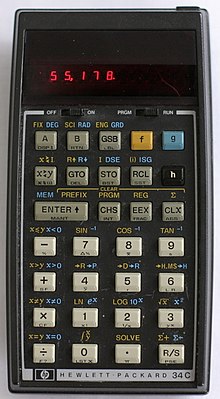HP 30 series
The pocket calculators of the "Thirties" series, also known as "Spice", represent the third generation of pocket calculators from Hewlett-Packard after the models in the "Twenties" series and were launched on the market in 1978. This series includes four models for scientific and two models for commercial use. All computers have an LED display and are powered by rechargeable NiCd cells that can be exchanged within the series.
The computers use reverse Polish notation (UPN) as the input method .
Models
The series includes the following models (with the year of their production):
- HP-31E - Mathematical and Scientific Calculator; Base model (1978–1980)
- HP-32E - Mathematical and Scientific Calculator; medium requirements (1978–1983)
- HP-33E / C - Programmable math and science calculator; medium requirements (33E: 1978–1983, 33C: 1979–1983)
- HP-34C - Programmable math and science calculator; high demands (1979–1983)
- HP-37E - financial calculator and successor to the HP-22 (1978-1983)
- HP-38E / C - Programmable Financial Calculator (38E: 1978–1981, 38C: 1979–1983)
The HP-31E
The HP-31E served as the basic model for simple mathematical and scientific problems and is the model with the smallest equipment in this series. It was remarkably affordable for its time at just $ 60. This was due to the fact that HP had developed a new, solder-free and efficient assembly method for these computers. This model already had trigonometric functions and unit conversions, but was not programmable.
The HP-32E
This next-better model also had statistical functions, factorial (x!), And additional conversion functions. This diversity makes it necessary to assign the keys three times. The HP-32E had more data storage than the base model, but it was still not programmable.
In 1988, under the name HP-32S , a considerably improved successor appeared with a similar aim, but which has nothing in common with this family technologically.
The HP-33E / C
The HP-33 was the simple programmable model in the range. Outwardly, it was very similar to the HP-32. Programmability made it necessary to forego most of the functions that were added to the HP-32. As was common at that time, all memory contents were lost when switching off; the later model HP-33C did not have this disadvantage.
The HP-34C
The HP-34 was the top model in the range and the first pocket calculator to have a numerical zero search and numerical integration preprogrammed. The arguments of these operations could be defined by the user in the form of a subroutine. The memory had been expanded considerably and was retained when it was switched off. Programming includes conditional branches, subroutines, and indexed addressing. With this model, the keys were assigned four times, as was the case with the HP-67 . The HP-34's application manual gave detailed explanations of these complex functions and also included two games.
The HP-37E
This model was aimed at commercial users and also had statistical functions.
The HP-38E / C
The higher-quality HP-38 had higher commercial functions such as cash flow analysis and date arithmetic and was the first programmable calculator for this area of application. Its keys were assigned three times, also a novelty for a commercial calculator. Similar to the HP-33, an improved version with non-volatile memory appeared a year after the first model.
manufacturing engineering
The first models in the series were manufactured without soldering, in that a metallic "backbone" pressed the chips onto a flexible circuit board. This allowed for efficient assembly, but it turned out that the reliability of earlier models could not be achieved in this way, as contact problems arose over time. In the early 1980s, the structure was therefore changed back to the original technology. These newer models have a rigid printed circuit board and are around 50 g lighter than the first models due to the elimination of the pressure frame.
Evaluation and successor
At the time of the appearance of these calculators, the electronics industry was in a stormy phase at a time when the market for pocket calculators was not yet saturated. It was particularly important for these devices that LC technology quickly began to establish itself. This was already used in 1979 in the HP-41 , as well as in the later computers, which quickly replaced the "Thirties". These computers were the last computers with light-emitting diode (LED) displays and were replaced by the HP-10C family at the beginning of the 1980s .
Web links
- HP 30 Series Technology and Packaging. Museum of HP Calculators
- Hewlett-Packard HP-34C. rskey.org
